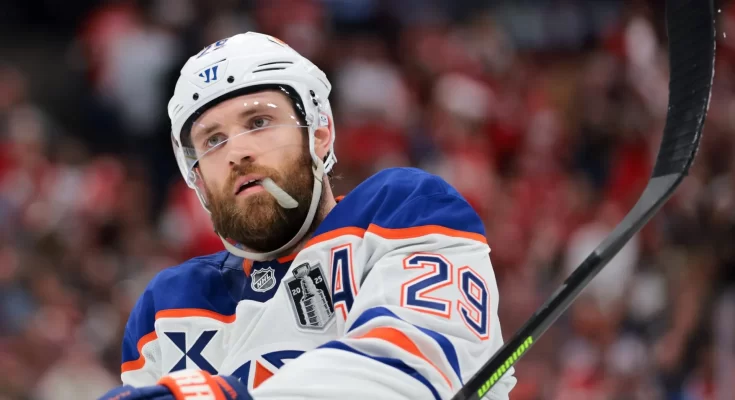Leon Draisaitl’s Projected $112 Million Payday Sparks Heated Debate Among NHL Insiders and Analysts
Leon Draisaitl has long been one of the NHL’s most dominant and dependable superstars, but with his next contract negotiation looming, recent reports suggesting a potential $112 million payday have ignited fierce debate throughout the hockey world. As the Edmonton Oilers look to secure the long-term future of their elite core, including both Draisaitl and Connor McDavid, insiders are beginning to dissect whether such a massive investment is justified—and what it means for the team’s championship window, cap strategy, and long-term flexibility. According to multiple NHL analysts, including those with deep insight into player valuation and market trends, the rumored figure has stirred both support and skepticism, particularly when viewed through the lens of performance analytics, positional scarcity, and future cap projections.
Draisaitl, who is set to become an unrestricted free agent following the 2025–26 season, has played the last few years on what many have called one of the NHL’s best bargains. His current contract, which carries an $8.5 million cap hit, has delivered exceptional value to the Oilers. Since signing that deal in 2017, the German forward has emerged as one of the most productive players in the league, winning the Hart Trophy in 2020, regularly finishing near the top of league scoring, and proving himself a crucial playoff performer. His chemistry with Connor McDavid has been a cornerstone of Edmonton’s offensive identity, creating one of the most dangerous one-two punches in hockey.
But as the league continues to evolve and player salaries rise with the expanding salary cap, Draisaitl is now in line for a significant raise. With several comparable players signing high-value contracts in recent seasons—including Auston Matthews, Nathan MacKinnon, and David Pastrnak—the bar has been reset. Matthews, for example, signed a four-year deal with an average annual value of $13.25 million, while MacKinnon became the league’s highest-paid player with an AAV of $12.6 million before Matthews surpassed him. Based on performance metrics and age, Draisaitl’s next deal could easily fall in the $14 to $16 million range annually, depending on term and structure, which would push a potential total close to or even above $112 million over eight years.
While many see this as a well-earned reward for a franchise cornerstone, others are beginning to ask tough questions. Can a team realistically win a Stanley Cup with two players taking up over $28 million in cap space, assuming McDavid also re-signs for a record-breaking deal? Are the Oilers prepared to sacrifice depth in other areas to keep their top-end talent intact? Will the projected cap increases over the next five years be enough to support such top-heavy team-building strategies?
These are questions NHL analysts are now publicly wrestling with. Some believe locking up Draisaitl at all costs is essential, given his status as arguably the best power forward in the league today. His ability to dominate at even strength, quarterback a power play, kill penalties, and elevate his game in high-stakes situations makes him a rare commodity. He’s not just a scorer—he’s a complete player with leadership qualities, playoff pedigree, and a massive impact on Edmonton’s locker room culture. From this perspective, $112 million might actually understate his true value, particularly if the cap increases at the pace some financial models are projecting.
But others take a more cautious view. Committing such a significant portion of the cap to two players introduces long-term risk. Injuries, declining performance, or even just year-to-year inconsistency can greatly affect a team’s return on investment. Analysts referencing salary cap efficiency models have pointed out that championship-winning teams often rely on a more balanced payroll, allowing them to spread resources across multiple positions and maintain strong depth lines. From this lens, the Oilers’ potential strategy to retain Draisaitl and McDavid at premium prices may limit their ability to adjust to injuries, develop role players, or strengthen their bottom six and defense corps.
There is also a discussion around market value versus internal value. On an open market, Draisaitl would unquestionably command a massive payday. Several franchises would be willing to offer top dollar for a player of his caliber. But Edmonton may have certain built-in advantages or disadvantages when it comes to retaining him. The team’s trajectory, playoff success, and front-office stability will all influence whether Draisaitl sees his long-term future in Alberta. Should negotiations turn difficult or the team underperform in the next year or two, the conversation could quickly shift from contract numbers to trade speculation—a scenario no Oilers fan wants to imagine but which analysts are duty-bound to explore.
From a marketing and business standpoint, keeping Draisaitl in Edmonton would also be a major win. He’s not only a hockey icon but a global ambassador for the sport, especially as one of the most prominent German players in NHL history. His presence expands the Oilers’ reach in international markets and contributes to brand strength, merchandise sales, and ticket demand. Factoring in these intangibles, many believe the organization views a large investment in Draisaitl not just as a hockey decision but as a strategic asset across multiple business verticals.
For fans and followers trying to understand the full scope of this evolving situation, it’s important to keep an eye on both league-wide trends and internal team dynamics. The 2025 offseason will be one of the most critical in recent memory for the Oilers, and the decisions made around Leon Draisaitl’s contract could determine whether this team ultimately fulfills its championship potential. Everything from McDavid’s future to the development of key prospects and the performance of the supporting cast will be part of the calculation.
From an SEO perspective, interest in Draisaitl’s contract future is surging. Search terms like “Leon Draisaitl contract rumors,” “Oilers Draisaitl next deal,” “NHL’s highest paid players 2025,” and “can Oilers afford Draisaitl and McDavid” are rapidly gaining traction. Long-tail keywords such as “how much will Leon Draisaitl sign for in 2025,” “Draisaitl projected new contract value,” and “Oilers salary cap impact of Draisaitl extension” are especially valuable for drawing niche audiences seeking deep-dive analysis.
As this story unfolds, expect continued scrutiny and discussion. Media coverage will dissect every quote from management, every hint from Draisaitl’s camp, and every performance metric that could impact contract talks. Whether the final deal matches the rumored $112 million figure or deviates from it, the broader question will remain the same—can the Edmonton Oilers build a Stanley Cup-winning team while paying two of the league’s top superstars historic money? Only time will tell. But what’s certain is that Leon Draisaitl’s next contract will be one of the defining storylines of the NHL in the coming year.



